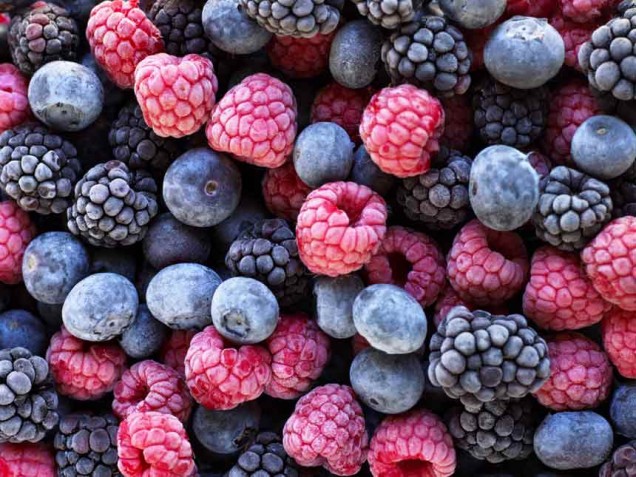On June 12, 1996, Ontario’s chief medical officer, Dr. Richard Schabas, issued a public health advisory on the presumed link between  consumption of California strawberries and an outbreak of diarrheal illness among some 40 people in the Metro Toronto area. The announcement followed a similar statement from the Department of Health and Human Services in Houston, Texas, who were investigating a cluster of 18 cases of Cyclospora illness among oil executives.
consumption of California strawberries and an outbreak of diarrheal illness among some 40 people in the Metro Toronto area. The announcement followed a similar statement from the Department of Health and Human Services in Houston, Texas, who were investigating a cluster of 18 cases of Cyclospora illness among oil executives.
Dr. Schabas advised consumers to wash California berries "very carefully" before eating them, and recommended that people with compromised immune systems avoid them entirely. He also stated that Ontario strawberries, which were just beginning to be harvested, were safe for consumption. Almost immediately, people in Ontario stopped buying strawberries. Two supermarket chains took California berries off their shelves, in response to pressure from consumers. The market collapsed so thoroughly that newspapers reported truck drivers headed for Toronto with loads of berries being directed, by telephone, to other markets.
However, by June 20, 1996, discrepancies began to appear in the link between California strawberries and illness caused by the parasite, Cyclospora, even though the number of reported illnesses continued to increase across North America. Texas health officials strengthened their assertion that California strawberries were the cause of the outbreak, while scientists at the U.S. Centers for Disease Control and Prevention (CDC) and the Food and Drug Administration (FDA) said there were not yet ready to identify a food vehicle for the outbreak. On June 27, 1996, the New York City Health Department became the first in North America to publicly state that raspberries were also suspected in the outbreak of Cyclospora.
By July 18, 1996, the CDC declared that raspberries from Guatemala — which had been sprayed with pesticides mixed with water that could have been contaminated with human sewage containing Cyclospora — were the likely source of the Cyclospora outbreak, which ultimately sickened about .jpg) 1,000 people across North America. Guatemalan health authorities and producers have vigorously refuted the charges. The California Strawberry Commission estimates it lost $15 million to $20 million in reduced strawberry sales.
1,000 people across North America. Guatemalan health authorities and producers have vigorously refuted the charges. The California Strawberry Commission estimates it lost $15 million to $20 million in reduced strawberry sales.
Cyclospora cayetanensis is a recently characterised coccidian parasite; the first known cases of infection in humans were diagnosed in 1977. Before 1996, only three outbreaks of Cyclospora infection had been reported in the United States. Cyclospora is normally associated with warm, Latin American countries with poor sanitation.
One reason for the large amount of uncertainty in the 1996 Cyclospora outbreak is the lack of effective testing procedures for this organism. To date, Cyclospora oocysts have not been found on any strawberries, raspberries or other fruit, either from North America or Guatemala. That does not mean that cyclospora was absent; it means the tests are unreliable and somewhat meaningless. FDA, CDC and others are developing standardized methods for such testing and are currently evaluating their sensitivity.
The initial, and subsequent, links between Cyclospora and strawberries or raspberries were therefore based on epidemiology, a statistical association between consumption of a particular food and the onset of disease. For example, the Toronto outbreak was first identified because some 35 guests attending a May 11, 1996 wedding reception developed the same severe, intestinal illness, seven to 10 days after the wedding, and subsequently tested positive for cyclospora. Based on interviews with those stricken, health authorities in Toronto and Texas concluded that California strawberries were the most likely source. However, attempts to remember exactly what one ate two weeks earlier is an extremely difficult task; and larger foods, like strawberries, are recalled more frequently than smaller foods, like raspberries. Ontario strawberries were never implicated in the outbreak.
Once epidemiology identifies a probable link, health officials have to decide whether it makes sense to warn the public. In retrospect, the decision seems straightforward, but there are several possibilities that must be weighed at the time. If the Ontario Ministry of Health decided to warn people that eating imported strawberries might be connected to Cyclospora infection, two outcomes were possible: if it turned out that strawberries are implicated, the ministry has made a smart decision, warning people against something that could hurt them; if strawberries were not implicated, then the ministry has made a bad decision with the result that strawberry growers and sellers will lose money and people will stop eating something that is good for them. If the ministry decides not to warn people, another two outcomes are possible: if strawberries were implicated, then the ministry has made a bad decision and people may get a parasitic infection they would have avoided had they been given the information (lawsuits usually follow); if strawberries were definitely not .jpg) implicated then nothing happens, the industry does not suffer and the ministry does not get in trouble for not telling people. Research is currently being undertaken to develop more rigorous, scientifically-tested guidelines for informing the public of uncertain risks.
implicated then nothing happens, the industry does not suffer and the ministry does not get in trouble for not telling people. Research is currently being undertaken to develop more rigorous, scientifically-tested guidelines for informing the public of uncertain risks.
But in Sarnia (Ontario, Canada) they got a lot of sick people who attended the Big Sisters of Sarnia-Lambton Chef’s Challenge on May 12, 2010.
The health department has completed interviews with over 270 people who attended the event. Of those people interviewed, 193 have reported being ill with symptoms consistent with cyclospora infection. There are currently 40 laboratory confirmed cases.
 Pomeberry product and an investigation is ongoing. This product has been distributed through Save-On-Foods and Overwaitea.
Pomeberry product and an investigation is ongoing. This product has been distributed through Save-On-Foods and Overwaitea.

(1).jpg) European countries.
European countries. August, 13 norovirus outbreaks affecting about 900 people could be linked to imported frozen raspberries. Two raspberry samples corresponding to two batches of raspberries were positive for norovirus. These two batches proved to have been the likely source in six of the 13 outbreaks. Analytical studies had not been conducted for six outbreaks, and virological test results were inconclusive in two. However, combining epidemiological and microbiological methods often enabled finding the source, as exemplified in investigation of a large school outbreak. To ensure prompt control measures in similar situations in the future, both aspects of outbreak investigations should be strengthened.
August, 13 norovirus outbreaks affecting about 900 people could be linked to imported frozen raspberries. Two raspberry samples corresponding to two batches of raspberries were positive for norovirus. These two batches proved to have been the likely source in six of the 13 outbreaks. Analytical studies had not been conducted for six outbreaks, and virological test results were inconclusive in two. However, combining epidemiological and microbiological methods often enabled finding the source, as exemplified in investigation of a large school outbreak. To ensure prompt control measures in similar situations in the future, both aspects of outbreak investigations should be strengthened.
 porn dinner:
porn dinner: consumption of California strawberries and an outbreak of diarrheal illness among some 40 people in the Metro Toronto area. The announcement followed a similar statement from the Department of Health and Human Services in Houston, Texas, who were investigating a cluster of 18 cases of Cyclospora illness among oil executives.
consumption of California strawberries and an outbreak of diarrheal illness among some 40 people in the Metro Toronto area. The announcement followed a similar statement from the Department of Health and Human Services in Houston, Texas, who were investigating a cluster of 18 cases of Cyclospora illness among oil executives..jpg) 1,000 people across North America. Guatemalan health authorities and producers have vigorously refuted the charges. The California Strawberry Commission estimates it lost $15 million to $20 million in reduced strawberry sales.
1,000 people across North America. Guatemalan health authorities and producers have vigorously refuted the charges. The California Strawberry Commission estimates it lost $15 million to $20 million in reduced strawberry sales..jpg) implicated then nothing happens, the industry does not suffer and the ministry does not get in trouble for not telling people. Research is currently being undertaken to develop more rigorous, scientifically-tested guidelines for informing the public of uncertain risks.
implicated then nothing happens, the industry does not suffer and the ministry does not get in trouble for not telling people. Research is currently being undertaken to develop more rigorous, scientifically-tested guidelines for informing the public of uncertain risks.